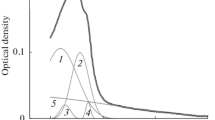Abstract
The fluorescence life-time of N-acetyl-tryptophan-amide (NATA) was measured by multifrequency phase fluorometry, in the presence of increasing concentrations of imidazole. Two pH values were tested, pH 4.5 where imidazole is fully protonated and pH 9.0 where it is fully unprotonated. At both pH values, the inverse life-time increases in a non-linear way with the imidazole concentration, showing that imidazole is not a high efficiency collisional quencher. The data can be analysed in terms of the formation of a complex with a reduced fluorescence life-time. The rate constants for association (at 25°C) are around 5 (±0.2) × 109 M−1 s−1 and are thus diffusion controlled. The association equilibrium constant is strongly pH dependent and is much higher than the expected value of 0.4 M−1 for a collisional complex. The intrinsic fluorescence life-time of the complex is 1.56 (±0.02) ns at pH 9.0 and 1.82 (±0.03) ns at pH 4.5, as compared to 2.37 (±0.03) ns for free NATA at pH 9.0 and 2.83 (±0.05) at pH 4.5 (all atI = 0.34). This means that at both pH values the fluorescence life-time of NATA in the complex is reduced to 61 (±0.5)% of its value in the free state. Despite this, the protonated form of imidazole is a better quencher at low concentrations, owing to a longer residence-time of the complex. At high viscosity the association equilibration is too slow and the system is described by two life-times. The quenching effect ofHis-18 on the fluorescence of the proximalTrp-94 of barnase (Locwenthal et al. 1991, Willaert et al. 1991) is discussed in terms of these findings.
Similar content being viewed by others
References
Bernasconi CF (1976) Relaxation kinetics. Academic Press, New York San Francisco London
Bevington PB (1969) Data reduction and error analysis for physical sciences, McGraw-Hill, New York
Bushueva TL, Busel EP, Bushuev VN, Burstein EA (1974) The interaction of protein functional groups with indole chromophore. I. Imidazole group. Studia Biophys 44:129–139
Bushueva TL, Busel EP, Burstein EA (1975) The interaction of protein functional groups with indole chromophore. III. Amine, amide and thiol groups. Studia Biophys 52:41–52
Clays K, Jannes J, Engelborghs Y, Persoons A (1989) Instrumental and analysis improvements in multifrequency phase fluorometry. J Phys E: Sci Instrum 22:297–305
Desie G, Boens N, De Schrijver FC (1986) Study of the time-resolved tryptophan fluorescence of crystalline α-chymotrypsin. Biochemistry 25:8301–8308
Loewenthal R, Sancho J, Fersht A (1991) The fluorescence spectrum of barnase: contributions of three tryptophan residues and a histidine-related pH-dependence Biochemistry 30:6775–6779
More JJ, Sorensen DC (1983) Computing a trust region step. SIAM J Sci Stat Comp 4:553–572
Shinitzky M, Goldman R (1967) Fluorometric detection of histidine-tryptophan complexes in peptides and proteins. Eur J Biochem 3:139–144
Strehlow H, Knoche W (1977) Fundamentals of chemical relaxation, Verlag Chemie, Weinheim New York
Szabo AG, Rayner DM (1980) Fluorescence decay of tryptophan conformers in aqueous solutions. J Am Chem Soc 102:554–563
Szabo AG, Rayner DM (1980) The time resolved emission spectra of peptide conformers by pulsed laser excitation, Biochem Biophys Res Commun 94:909–915
Van Belle D, Prevost M, Wodak SJ (1989) Electrostatic properties of solvated proteins: a microscopic analysis based on computer simulation. Chem Scr 29A:181–189
Waldman ADB, Clarke AR, Wigley DB, Hart KW, Chia WN, Barstow D, Atkinson T, Munro I, Holbrook JJ (1987) The use of site-directed mutagenesis and time-resolved fluorescence spectroscopy to assign the fluorescence contributions of individual tryptophan residues inBacillus stearother-mophilus lactate dehydrogenase. Biochim Biophys Acta 913:66–71
Willaert K, Loewenthal R, Sancho J, Froeyen M, Fersht A, Engelborghs Y (1991) Determination of the excited state life-times of the tryptophan residues in barnase, via multifrequency phase fluorometry of tryptophan mutants Biochemistry (submitted for publication)
Author information
Authors and Affiliations
Rights and permissions
About this article
Cite this article
Willaert, K., Engelborghs, Y. The quenching of tryptophan fluorescence by protonated and unprotonated imidazole. Eur Biophys J 20, 177–182 (1991). https://doi.org/10.1007/BF01561140
Received:
Accepted:
Issue Date:
DOI: https://doi.org/10.1007/BF01561140




